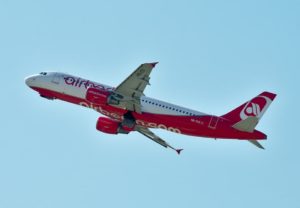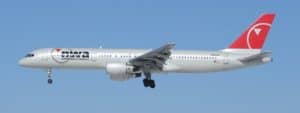The age-old question that has plagued humanity for centuries: which is better, an Airbus A320 or a Boeing 757? Some people swear by the Airbus, while others are diehard fans of the 757. But who is right? And more importantly, who is wrong?
These two planes have been battling it out for years, each claiming to be superior to the other. The Airbus boasts a more extended range and can hold more passengers, while the 757 is known for its speed and agility. So which one comes out on top? Let’s look at both planes and see what they offer.
| Aircraft: | Airbus A320-200 | Boeing 757-200 |
|---|---|---|
| Photo: |
 |
 |
| Country: | France | United States |
| Manufactured: | from: 1988 to: Present | from: 1982 to: 2005 |
| ICAO: | A320 | B752 |
| Price: | $101 million | $65 million |
| Avionics: | Thales Avionics Suite | Rockwell Collins CRT |
| Engine: | 2x IAE V2500 or CFM International CFM56-5B | 2x Pratt & Whitney PW2037 |
| Engine Type: | Turbofan | Turbofan |
| Power: | 27,000 pound-force | 42,600 pound-force |
| Max Cruise Speed: |
514 knots 952 Km/h |
496 knots 919 Km/h |
| Approach Speed (Vref): | 137 knots | 140 knots |
| Travel Range: |
3,300 Nautical Miles
6,112 Kilometers |
3,915 Nautical Miles
7,251 Kilometers |
| Fuel Economy: |
0.45 nautical mile / gallon 0.220 kilometres / litre |
- |
| Service Ceiling: | 39,000 feet | 42,000 feet |
| Rate of Climb: |
2500 feet / minute 12.70metre / second |
3500 feet / minute 17.78metre / second |
| Take Off Distance: |
2100 metre 6,889.68 feet |
2070 metre 6,791.26 feet |
| Landing Distance: |
1540 metre 5,052.43 feet |
1400 metre 4,593.12 feet |
| Max Take Off Weight: |
78,000 Kg 171,959 lbs |
99,800 Kg 220,019 lbs |
| Max Landing Weight: |
66,000 Kg 145,504 lbs |
89,800 Kg 197,973 lbs |
| Max Payload: |
19,950 Kg 43,982 lbs |
25,920 Kg 57,143 lbs |
| Fuel Tank Capacity: |
7,841 gallon 29,681 litre |
11,276 gallon 42,684 litre |
| Baggage Volume: |
37.42 m3 1,321 ft3 |
47 m3 1,660 ft3 |
| Seats - Economy: | 190 seats | 239 seats |
| Seats - Business Class: | 148 seats | - |
| Seats - First Class: | - | - |
| Cabin Height: |
2.22 metre 7.28 feet |
2.1 metre 6.89 feet |
| Cabin Width: |
3.7 metre 12.14 feet |
3.5 metre 11.48 feet |
| Cabin Length: |
27.5 metre 90.22 feet |
38.3 metre 125.65 feet |
| Exterior Length: |
37.57 metre 123.26 feet |
47.3 metre 155.18 feet |
| Tail Height: | 12.08 metre - 39.63 feet | 13.6 metre - 44.62 feet |
| Fuselage Diameter: |
3.95 metre 12.96 feet |
3.8 metre 12.47 feet |
| Wing Span / Rotor Diameter: |
35.8 metre 117.45 feet |
38 metre 124.67 feet |
| Wing Tips: | Wingtip Fences | No Winglets |
| More Info: | Airbus A320-200 | Boeing 757-200 |
|
Data presented is for entertainment purposes and should not be used operationally.
|
Other Airbus A320-200 comparisons:
Other Boeing 757-200 comparisons:
About the Airbus A320
The Airbus A320 is a medium-haul, single-aisle aircraft that seats up to 150 passengers. It has a range of 3,300 to 3,600 nautical miles and a cruising speed of Mach 0.78. It is powered by two turbofan engines and can fly up to 41,000 feet. It is also equipped with modern avionics and fly-by-wire controls, making it easier to fly.
It has a tall landing gear to accommodate the many engines used on early models, which had four engines. There are now only two engine options for the A320, the CFM56 and the IAE V2500. All variations have a 10-abreast seating configuration in a single-aisle cabin.
The A320 has an efficient design, making it a popular airline choice. It is fuel efficient and has low operating costs. The cabin is spacious and comfortable for passengers. The aircraft is also equipped with modern technology, such as GPS and an EFIS (Electronic Flight Instrument System).
The A320 is one of the most successful aircraft ever produced. It has been ordered by over 5,000 customers and delivered to over 1,000 operators in more than 180 countries. The aircraft has a good safety record and is known for its reliability.
Why was it developed and built?
The Airbus A320 was developed in response to the growing demand for more efficient aircraft. It was built using modern technology, such as fly-by-wire systems and advanced avionics. This allows the aircraft to fly more efficiently, increasing its range and improving its performance. The A320 was designed to be a cost-effective option for airlines, offering them an affordable and reliable aircraft.
What purpose did it serve?
It served as an affordable and reliable alternative to larger wide-body aircraft, allowing airlines to provide passengers with a comfortable and safe experience. It is capable of short-haul, mid-haul, and long-haul flights. Its efficient design has made it one of the most successful aircraft ever produced.
About the Boeing 757
The Boeing 757 is a narrow-body, twin-engine airliner. It has a range of 3,400 to 3,700 nautical miles and a cruising speed of Mach 0.71. It can fly at altitudes of up to 45,000 feet and has a maximum takeoff weight of 255,000 pounds. It typically seats between 200 and 239 passengers in a two-class configuration.
The 757 was designed to be an efficient short-to-medium-range airliner that could replace the 727 and early 737 models. It has become a popular choice for airlines operating short or medium-haul flights. It is a versatile aircraft that can be used for both passenger and cargo operations.
It has been in continuous production since its introduction in 1982, and it has been updated over the years with various modifications, such as winglets, advanced avionics, and more robust engines. It is still in production and is a popular choice for airlines worldwide. More than 1,050 Boeing 757s have been produced since its introduction.
It has earned an excellent safety record over the years, with no significant incidents or fatalities attributed to it. It is one of the safest aircraft in the world, and its design has been proven over time. It is a reliable, efficient, and secure aircraft asset to airlines.
Also Read: Top 15 Largest Airlines in the World
Why was it developed and built?
It was built as a replacement for the 727 and early 737 models. It was designed to be an efficient short-to-medium-range airliner that could also serve as a cargo aircraft. The 757 is known for its fuel efficiency, low operating costs, and advanced avionics, making it a popular choice amongst airlines.
What purpose does it serve?
It serves several purposes, including short-haul, mid-haul, and long-haul flights.
Its excellent safety record makes it one of the safest aircraft in the world. The 757 continues to be an asset for many airlines and will remain a popular choice for years to come.
How are Airbus A320 and Boeing 757 different?
Looking at an Airbus A320 and a Boeing 757 side by side, the most noticeable difference between the two aircraft is the shape of their nose.
The Boeing has a more pointed nose, while the Airbus has a rounded nose. The difference in the shape of the nose is due to the different engines used on each plane. The A320 uses CFM56 engines, designed to be more fuel efficient than the engines used on the 757.
The differences in the shape of the nose and the engines have a significant impact on the performance of each plane.
The A320 can take off and land at shorter airstrips than the 757 and has a higher maximum cruising altitude. In addition, the A320 is configured for longer-range flights, with a maximum range of over 4,000 miles. On the other hand, the 757 is designed for shorter flights and has a range of just over 3,000 miles.
Regarding capacity, the A320 can seat up to 180 passengers, while the 757 can seat up to 200 passengers. So, while there are some similarities between these two aircraft, there are also several significant differences.
How are Airbus A320 and Boeing 757 similar?
Despite their appearance and performance differences, the Airbus A320 and Boeing 757 have some similarities.
One of the most notable similarities is that both aircraft are designed for short- to medium-haul flights. In addition, they both have a two-class cabin configuration, with seating for up to 200 passengers.
The engines of each plane are also similar, using high-bypass turbofan engines. The A320 has CFM International’s CFM56 engines, while the 757 uses Pratt & Whitney or Rolls Royce RB211–535E4B engines.
Finally, both aircraft have an excellent safety records and are widely used by airlines worldwide.
What’s better about the Airbus A320?
Engines:
The CFM56 engines on the A320 are more fuel-efficient than the engines used on the 757.
Range:
The A320 has a more extended range, with a maximum of over 4,000 miles compared to just over 3,000 for the 757.
Takeoff and Landing Capabilities:
Due to its engine design, the A320 can take off and land at shorter airstrips than the 757.
Capacity:
The A320 can seat up to 180 passengers, while the 757 can only seat 200.
What’s better about the Boeing 757?
Versatility:
The 757 is a highly versatile aircraft that can be used for both passenger and cargo operations.
Speed:
The 757 has a higher maximum cruising altitude, giving it a slight speed advantage over the A320.
Cabin Space:
The 757 has larger cabin space than the A320 due to its wider fuselage. This provides more room for passengers on long-haul flights.
Conclusion
In conclusion, the Airbus A320 and the Boeing 757 are excellent aircraft that have stood the test of time regarding reliability, efficiency, and safety.
While the A320 has a more extended range and can hold more passengers, the 757 is known for its speed and agility. Ultimately, the airline will decide which aircraft best suits their particular needs.
No matter which one they choose, however, they can both be sure to receive an efficient and safe aircraft that will serve them well for years to come.


